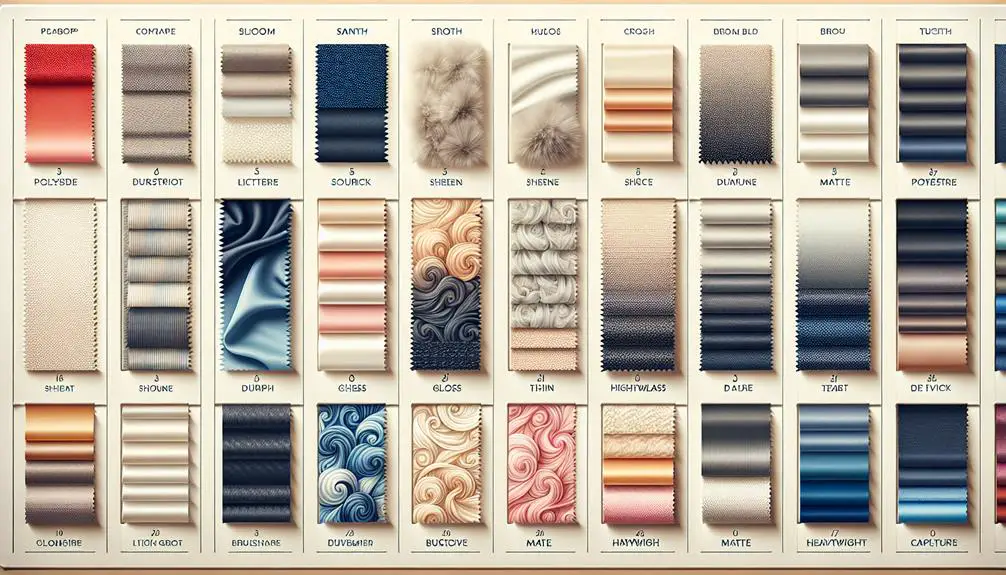I'd recommend recycled polyester for the best choice. Brands like Nike and Patagonia use this eco-friendly option, lowering environmental impact. Recycled polyester offers high performance similar to virgin polyester but reduces harm to the environment. It diverts plastic waste from landfills and cuts energy consumption by up to 50%. Choosing this sustainable material showcases a commitment to environmental responsibility. If you want to discover more about why recycled polyester stands out, keep exploring other aspects like its creation process and industry trends.
Table of Contents
Key Takeaways
- Recycled polyester is best for the environment, sourced from post-consumer PET plastic.
- It reduces energy consumption by up to 50% compared to virgin polyester.
- Recycled polyester emits 55% fewer greenhouse gases than virgin polyester.
- Brands like Nike and Patagonia use eco-friendly recycled polyester in their products.
- Choosing recycled polyester showcases commitment to sustainability and environmental responsibility.
Properties of Different Polyester Types
When examining the properties of various polyester types, it's important to take into account their distinct features and environmental impact.
Recycled polyester, particularly sourced from post-consumer PET plastic, stands out for its high-performance capabilities. Brands like Nike and Patagonia have embraced this eco-friendly material in their products. This type of polyester, such as that produced by Repreve from recycled PET water bottles, offers the same benefits as virgin polyester but with a much lower environmental impact.
It's heartening to see the fashion industry shifting towards sustainable practices by incorporating recycled polyester into their clothing lines. Not only does this help reduce the reliance on new fossil fuels, but it also demonstrates that high-quality, environmentally friendly options are readily available.
Environmental Impact of Polyester Production
High levels of energy and water are consumed during the production of polyester, contributing markedly to environmental strain. The manufacturing process generates pollution, releasing harmful chemicals into the environment. As polyester is non-biodegradable, it leads to long-term waste accumulation in landfills and oceans, exacerbating the negative impact on the planet.
The widespread use of traditional polyester further intensifies these environmental challenges. However, there's a more sustainable alternative – recycled polyester. By utilizing recycled materials, the need for new petroleum-based resources is reduced, lessening the strain on the environment. Opting for recycled polyester can help mitigate the environmental impact of polyester production and disposal.
When considering polyester options, it's imperative to weigh the environmental consequences and opt for choices that align with sustainable practices. Choosing recycled polyester over traditional polyester can make a significant difference in reducing the environmental footprint of polyester production.
Creation and Production Processes Comparison
Let's compare how polyester is made and the impact it has on the environment.
From sourcing methods to manufacturing techniques and evaluating environmental effects, we can gain insights into the processes involved.
This examination will shed light on the complexities of polyester production and its implications for sustainability.
Material Sourcing Methods
In exploring the creation and production processes of polyester, it becomes evident that the sourcing methods play a significant role in determining the environmental impact and sustainability of the material.
- Traditional polyester: Made from virgin polyethylene terephthalate (PET) derived from petroleum.
- Recycled polyester: Created by collecting and processing post-consumer PET plastic.
- Environmental impact: Traditional polyester production contributes to high energy consumption, water usage, and pollution.
- Sustainability: Recycled polyester offers a more eco-friendly alternative, reducing the need for new fossil fuels.
Choosing between recycled and traditional polyester can have a significant impact on the environment and the future of sustainable fashion.
Manufacturing Techniques Overview
When considering the manufacturing techniques of polyester, it becomes evident that the processes involved vary greatly in their environmental impact and sustainability.
Traditional polyester production involves a chemical reaction using petroleum, water, and air, which is energy-intensive and contributes to environmental pollution. This method is commonly used for single-use plastic items like water bottles due to its cost-effectiveness.
In contrast, recycled polyester, made from post-consumer PET plastic, offers a more sustainable alternative to virgin polyester. Brands such as Nike and Patagonia are making the shift to recycled polyester to reduce their reliance on new fossil fuels.
Environmental Impact Assessment
Considering the environmental impact of polyester creation and production processes, it's important to evaluate the sustainability of traditional methods against the more eco-friendly alternatives like recycled polyester.
- Traditional polyester production consumes high energy and water levels.
- Polyester is derived from polyethylene terephthalate (PET), commonly found in single-use plastic bottles.
- Fast and cost-effective production methods make polyester widely used in fashion and activewear.
- The non-biodegradable nature of polyester and its reliance on non-renewable raw materials pose significant environmental concerns.
Recycled polyester, crafted from post-consumer PET plastic, presents a sustainable alternative by reducing reliance on new fossil fuels and supporting circular fashion practices.
Sustainability Aspect of Recycled Polyester
Let's chat about the sustainability side of recycled polyester.
I'll be covering eco-friendly sourcing practices, energy-saving production methods, and waste reduction initiatives.
It's exciting to see how recycled polyester is making a positive impact on the environment!
Eco-Friendly Sourcing Practices
Recycled polyester stands as a sustainable alternative sourced from post-consumer PET plastic, reducing our reliance on new fossil fuels.
Manufacturers collect used PET plastic from various sources to create recycled polyester fabrics.
Brands like Nike and Patagonia have adopted recycled polyester to promote eco-friendly practices.
Repreve, a leading recycled fiber manufacturer, has converted billions of PET water bottles into fabric.
Recycled polyester offers the same performance benefits as virgin polyester while lessening harm to the environment.
Energy-Saving Production Methods
Decreasing energy consumption considerably, recycled polyester offers a sustainable production method that benefits both the environment and the industry. Recycled polyester reduces energy usage by up to 50% compared to virgin polyester production. It takes 33-53% less energy to produce recycled polyester from PET bottles than from scratch. This process helps divert plastic waste from landfills and oceans, promoting sustainability. Additionally, the production of recycled polyester emits 55% fewer greenhouse gases than virgin polyester manufacturing. Sustainable brands are increasingly adopting recycled polyester to minimize their environmental impact and encourage eco-conscious practices.
| Energy-Saving Benefits of Recycled Polyester | ||
|---|---|---|
| Reduces energy consumption by up to 50% | Takes 33-53% less energy than creating from scratch | Emits 55% fewer greenhouse gases than virgin polyester |
| Helps divert plastic waste from landfills | Promotes sustainability | Encourages eco-conscious practices |
Waste Reduction Initiatives
Initiating a sustainable approach through waste reduction initiatives, the utilization of recycled polyester showcases a commitment to environmental responsibility and resourcefulness within the fashion industry.
- Recycled polyester is made from post-consumer PET plastic, reducing reliance on new fossil fuels.
- Manufacturers collect used PET plastic from various sources to create recycled polyester.
- Repreve, a leading brand, has recycled billions of PET water bottles into fabric, promoting waste reduction.
- Recycled polyester garments are in high demand due to their sustainability and environmental benefits.
Brand Shift Towards Recycled Polyester
As leading brands like Nike and Patagonia increasingly embrace sustainability, a noticeable shift towards incorporating recycled polyester in their products is becoming more prevalent. Recycled polyester, derived from post-consumer PET plastic, plays a significant role in reducing the reliance on new fossil fuels for production. Manufacturers like Repreve have been at the forefront, recycling billions of PET water bottles into fabric for garments, contributing to the eco-friendly movement.
The shift to recycled polyester aligns with the growing consumer demand for sustainable clothing choices. With the environmental impact of fashion coming under scrutiny, more people are opting for garments that prioritize sustainability without compromising on performance. Recycled polyester offers the same benefits as virgin polyester, ensuring that consumers can enjoy high-quality apparel while minimizing harm to the planet.
This movement towards recycled polyester signifies a positive change in the industry's approach to production and consumption, highlighting a collective effort towards a more sustainable future.
Consumer Demand for Sustainable Clothing
With leading brands like Nike and Patagonia embracing recycled polyester, it's evident that consumer demand for sustainable clothing is driving a significant shift in the fashion industry.
Consumers are increasingly seeking eco-friendly materials, such as recycled polyester, in their clothing choices. Brands are actively responding to this demand by integrating recycled polyester into their product lines to lessen environmental impact. Recycled polyester, derived from post-consumer PET plastic, helps reduce landfill waste and lessens the reliance on new fossil fuel production. Industry giants like Nike and Patagonia have adopted recycled polyester to meet the growing consumer expectation for sustainability in fashion.
The surge in demand for sustainable clothing signifies a broader trend towards environmentally conscious consumerism. As more individuals prioritize eco-friendly materials like recycled polyester, the fashion industry is compelled to adapt by offering more sustainable options. This consumer-driven shift highlights the increasing importance of sustainability in the fashion world.
Reducing Environmental Impact Through Recycled Polyester
Recycled polyester, a sustainable alternative to traditional fabrics, plays an essential role in reducing environmental impact within the fashion industry. Made from post-consumer PET plastic, recycled polyester helps decrease the reliance on new fossil fuels while maintaining similar performance attributes to virgin polyester.
Major brands like Nike and Patagonia have integrated recycled polyester into their garments, showcasing a commitment to sustainability. Companies like Repreve have recycled billions of PET water bottles into fabric, meeting the increasing demand for sustainable fashion options.
The rise in consumer awareness regarding the environmental impact of polyester has notably contributed to the trend towards recycled polyester, especially in activewear where performance and sustainability are paramount. By choosing recycled polyester over conventional options, individuals can actively participate in reducing the fashion industry's environmental footprint, supporting a more eco-conscious approach to clothing production and consumption.
Polyester Production and Consumption Trends
Moving from the discussion on reducing environmental impact through recycled polyester, the current focus shifts towards the trends in polyester production and consumption worldwide.
- Global Output: Polyester production has seen a significant increase, surpassing 52 million metric tons in 2020.
- China's Dominance: China stands out as the largest producer of polyester globally, playing an essential role in the industry's output.
- Textile Industry Impact: The textile sector consumes the majority of polyester production, utilizing it in diverse applications ranging from clothing to industrial uses.
- Cost-Effectiveness and Versatility: Polyester's popularity stems from its cost-effectiveness, durability, and versatility, making it a favored choice in both fast fashion and durable products.
Understanding the dynamics of polyester production and consumption trends is crucial in grasping the global textile industry's landscape. As the demand for polyester continues to rise, keeping an eye on these trends can provide valuable insights into the market's direction and potential opportunities for sustainable practices.
Importance of Choosing Sustainable Polyester
Choosing sustainable polyester over traditional options is vital for reducing the environmental impact of polyester production. Sustainable polyester is crafted from recycled materials such as post-consumer PET plastic bottles.
By opting for sustainable polyester, you're actively supporting the circular economy by decreasing waste and encouraging recycling practices. Not only does sustainable polyester help in lessening the environmental footprint, but it also possesses similar performance qualities to conventional polyester, ensuring that you don't compromise on functionality.
As brands and consumers increasingly prioritize sustainability, opting for sustainable polyester has become an essential step towards building a more eco-friendly wardrobe. Making the switch to sustainable polyester is a tangible way to contribute to a greener future while still enjoying the benefits of this versatile material.
Frequently Asked Questions
What Is the Best Type of Polyester?
In my experience, the best type of polyester varies based on needs. Consider fine denier blends for a soft touch, performance blends with natural fibers for comfort, moisture-wicking fabrics for active pursuits, recycled options for sustainability, or antimicrobial treatments for odor resistance.
Is 60% Cotton 40% Polyester Good Quality?
I find that a blend of 60% cotton and 40% polyester offers great quality. It combines comfort and durability, giving the softness of cotton along with the strength of polyester. It's versatile, easy to care for, and maintains shape and color well.
What Are the 3 Grades of Polyester?
Sure, let's explore the 3 grades of polyester. Low tenacity for light use, medium for moderate needs, and high tenacity for heavy-duty tasks. Each grade suits different purposes based on strength and durability requirements.
What Are 3 Types of Polyester?
Sure, let's talk about the three types of polyester: PET, PCDT, and PTT. Each type has unique properties for various applications. PET is common in textiles, PCDT is heat and chemical resistant, and PTT is elastic, soft, and eco-friendly.
- Kevlar Knife Resistance: Can It Withstand Sharp Objects? - June 21, 2025
- Kevlar Vs Fiberglass: Choosing the Right Composite Material - June 21, 2025
- Kevlar Fire Fighter Apron: Protection and Durability - June 21, 2025






